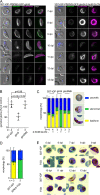A Microtubule-Associated Protein Is Essential for Malaria Parasite Transmission
- PMID: 36625655
- PMCID: PMC9973338
- DOI: 10.1128/mbio.03318-22
A Microtubule-Associated Protein Is Essential for Malaria Parasite Transmission
Erratum in
-
Erratum for Wichers-Misterek et al., "A Microtubule-Associated Protein Is Essential for Malaria Parasite Transmission".mBio. 2023 Oct 31;14(5):e0178623. doi: 10.1128/mbio.01786-23. Epub 2023 Sep 29. mBio. 2023. PMID: 37772956 Free PMC article. No abstract available.
Abstract
Mature gametocytes of Plasmodium falciparum display a banana (falciform) shape conferred by a complex array of subpellicular microtubules (SPMT) associated with the inner membrane complex (IMC). Microtubule-associated proteins (MAPs) define MT populations and modulate interaction with pellicular components. Several MAPs have been identified in Toxoplasma gondii, and homologues can be found in the genomes of Plasmodium species, but the function of these proteins for asexual and sexual development of malaria parasites is still unknown. Here, we identified a novel subpellicular MAP, termed SPM3, that is conserved within the genus Plasmodium, especially within the subgenus Laverania, but absent in other Apicomplexa. Conditional knockdown and targeted gene disruption of Pfspm3 in Plasmodium falciparum cause severe morphological defects during gametocytogenesis, leading to round, nonfalciform gametocytes with an aberrant SPMT pattern. In contrast, Pbspm3 knockout in Plasmodium berghei, a species with round gametocytes, caused no defect in gametocytogenesis, but sporozoites displayed an aberrant motility and a dramatic defect in invasion of salivary glands, leading to a decreased efficiency in transmission. Electron microscopy revealed a dissociation of the SPMT from the IMC in Pbspm3 knockout parasites, suggesting a function of SPM3 in anchoring MTs to the IMC. Overall, our results highlight SPM3 as a pellicular component with essential functions for malaria parasite transmission. IMPORTANCE A key structural feature driving the transition between different life cycle stages of the malaria parasite is the unique three-membrane pellicle, consisting of the parasite plasma membrane (PPM) and a double membrane structure underlying the PPM termed the inner membrane complex (IMC). Additionally, there are numerous linearly arranged intramembranous particles (IMPs) linked to the IMC, which likely link the IMC to the subpellicular microtubule cytoskeleton. Here, we identified, localized, and characterized a novel subpellicular microtubule-associated protein unique to the genus Plasmodium. The knockout of this protein in the human-pathogenic species P. falciparum resulted in malformed gametocytes and aberrant microtubules. We confirmed the microtubule association in the P. berghei rodent malaria homologue and show that its knockout results in a perturbed microtubule architecture, aberrant sporozoite motility, and decreased transmission efficiency.
Keywords: Plasmodium falciparum; gametocytogenesis; malaria; microtubule.
Conflict of interest statement
The authors declare no conflict of interest.
Figures





References
-
- WHO. 2020. World malaria report 2020.
-
- Liu W, Sundararaman SA, Loy DE, Learn GH, Li Y, Plenderleith LJ, Ndjango JBN, Speede S, Atencia R, Cox D, Shaw GM, Ayouba A, Peeters M, Rayner JC, Hahn BH, Sharp PM. 2016. Multigenomic delineation of Plasmodium species of the Laverania subgenus infecting wild-living chimpanzees and gorillas. Genome Biol Evol 8:1929–1939. doi:10.1093/gbe/evw128. - DOI - PMC - PubMed
-
- Liu W, Sherrill-Mix S, Learn GH, Scully EJ, Li Y, Avitto AN, Loy DE, Lauder AP, Sundararaman SA, Plenderleith LJ, Ndjango JBN, Georgiev AV, Ahuka-Mundeke S, Peeters M, Bertolani P, Dupain J, Garai C, Hart JA, Hart TB, Shaw GM, Sharp PM, Hahn BH. 2017. Wild bonobos host geographically restricted malaria parasites including a putative new Laverania species. Nat Commun 8:1635. doi:10.1038/s41467-017-01798-5. - DOI - PMC - PubMed
-
- Otto TD, Gilabert A, Crellen T, Böhme U, Arnathau C, Sanders M, Oyola SO, Okouga AP, Boundenga L, Willaume E, Ngoubangoye B, Moukodoum ND, Paupy C, Durand P, Rougeron V, Ollomo B, Renaud F, Newbold C, Berriman M, Prugnolle F. 2018. Genomes of all known members of a Plasmodium subgenus reveal paths to virulent human malaria. Nat Microbiol 3:687–697. doi:10.1038/s41564-018-0162-2. - DOI - PMC - PubMed
Publication types
MeSH terms
Substances
LinkOut - more resources
Full Text Sources
Medical
